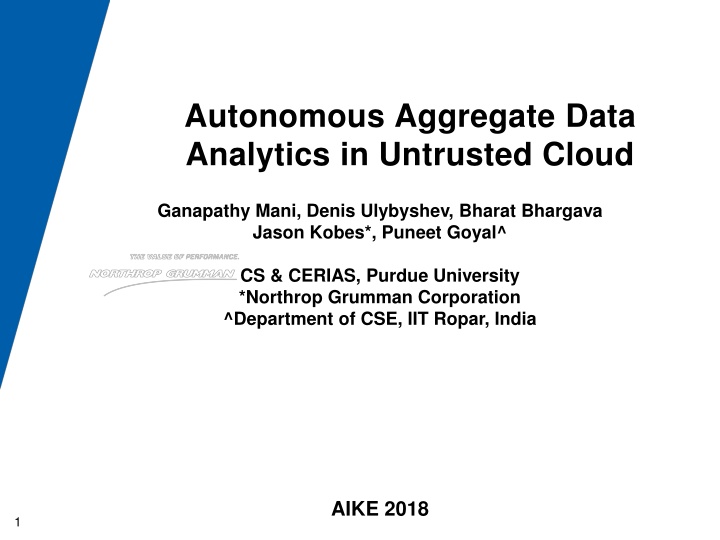
Intelligent Autonomous Data Analytics and Privacy Preservation in Distributed Environments
Explore the intersection of autonomous data analytics, intelligent autonomous systems, and privacy preservation in distributed environments. Learn about Active Bundle (AB) for privacy-preserving data aggregation and the importance of maintaining individual privacy in autonomous systems. Discover the concept of Comprehensive IAS Architecture for adaptive action and anomaly detection.
Uploaded on | 2 Views
Download Presentation

Please find below an Image/Link to download the presentation.
The content on the website is provided AS IS for your information and personal use only. It may not be sold, licensed, or shared on other websites without obtaining consent from the author. If you encounter any issues during the download, it is possible that the publisher has removed the file from their server.
You are allowed to download the files provided on this website for personal or commercial use, subject to the condition that they are used lawfully. All files are the property of their respective owners.
The content on the website is provided AS IS for your information and personal use only. It may not be sold, licensed, or shared on other websites without obtaining consent from the author.
E N D
Presentation Transcript
Autonomous Aggregate Data Analytics in Untrusted Cloud Ganapathy Mani, Denis Ulybyshev, Bharat Bhargava Jason Kobes*, Puneet Goyal^ CS & CERIAS, Purdue University *Northrop Grumman Corporation ^Department of CSE, IIT Ropar, India AIKE 2018 1
Intelligent Autonomous Systems Autonomous Systems should be Able to perform complex tasks without or with limited ongoing connection to humans. Cognitive enough to act without a human s judgment lapses or execution inadequacies. Intelligent Autonomous Systems (IAS) are characterized as highly Cognitive,effective in Knowledge Discovery, Reflexive, and Trusted. The focus of this research will be on the smart cyber systems. 2
Comprehensive IAS Architecture Adaptive action Anomaly Detection 3
Motivation Autonomous systems operating in distributed environment have to collectively learn from one another. It is important to maintain the privacy of individual entities generating data and humans interacting with them. Autonomous systems should be able to Learn from restricted information Preserve privacy while collectively learning about the distributed environment. 4
Privacy Preserving Autonomous Data Aggregation Using Active Bundle (AB), a distributed self-protecting entity with policy enforcement engine, we implement - One-time access certificate used to query other ABs - Privacy preserving numerical data aggregation analytics on Instead of checking AB s authentication protocol every time, an AB can obtain a one-time pass to access other ABs data per aggregate query. Numerical data is perturbed for the analytics and at the end the perturbation is removed. 5
Active Bundle (AB) Active Bundle (AB) is a distributed self-protecting entity with policy enforcement engine. Sensitive data is stored in a non relational database in the form of key-value pair. E.g. {PatientID = ENC(123456) }. Authentication of client services is based on digital certificates. The services present their X.509 certificates signed by a trusted Certificate Authority (CA). After authentication, policy enforcement engine enforces policies of data access depending upon the service s access level. 6
AB Authentication Protocol - Problem Every time a service requests a particular data from active bundle, it has to go through authentication and enforcement policies. For each Active Bundle, based on number of policies, the data access time increases. - Around 500 msec for 16 policies For each Active Bundle, based on security protocols of authentication, the authentication time increases. - Around 550 msec for two-way encryption So the system is not scalable for large databases and data analytics will become enormously time consuming. 8
One-time AB Authentication Protocol - Solution We propose a solution: one-time authentication per aggregated query. Here, each autonomous entity such as active bundle can be given a one-time certificate to perform a specific task without going through policies and authentication for each AB. One trusted Certificate Authority (CA) can provide the autonomous entity a one-time access pass and restrict the pass to the requested data. With this one time authentication, AB can surpass other ABs policies and authentication, making it faster. 9
One-time AB Authentication Protocol Here, a trusted ABi provides access certificate to another ABj. ABj uses the certificate to access other ABs without having to go through policies again. 10
Privacy Preserving Data Aggregation After passing the authentication and policies enforced by AB s policy enforcement engine, aggregate data analytics can be performed. AB s provenance data is used for aggregated analytics such as Count, Average, etc. on qualified attributes. These aggregate analytics guarantee privacy of individual ABs. Consider an aggregation, AB1 s age attribute is perturbed: Age (a) + Random Perturbation (R) 2AB2(a + an = an1) + 2AB1(a + r = an) + Final average = (ann R) / count(2AB) 12
Evaluation We measure the latency of data request sent to AB, which is hosted by a local server, located in the same network with the client. As a latency parameter, we record Round-Trip Time (RTT) for the data request processing at the server side (Note: we do not consider network delays in this experiment). ApacheBench measurements. We run 50 requests in a row and compute RTT average. v2.3 is used to calculate RTT 13
Evaluation Our initial work shows that the policies enforced for each AB access raise the access time exponentially where as a simple python simulation of file access (one time authentication example) stays almost constant for multiple entities. 14
Future Work Changing policies on-the-fly is a non-trivial problem in autonomous cyber systems. Autonomous policy changes based on the data analytics can be achieved by introducing an adaptive block with probabilistic rules. We plant to implement deep learning methodologies for adapting to new and unknown scenarios, learn from the data, and make probabilistic reasoning to enforce policies. 15
Future Work Autonomous policy changes based on the data analytics. 16
References 17
Thank you!!! 18
